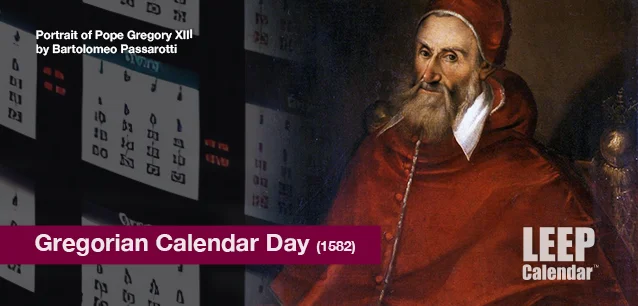 AD
AD
Today is: December 10
Scroll to explore events active on this date.
Additional Events on LEEP
LEEP INK FEATURES

August? Absolutely!
In August, we live through the Dog Days of Summer. It's hot and often humid, and those who can leave for better climates do. Down south, winter is in full force. August is also known as "the ...

In The Heat of July: July 2025 Events
Is it hot enough (or cold enough if you're below the equator) for you yet? There is actually a day for that! Like every month, I pick a diverse collection of events you may or may not know about. This ...

May Blooms: Events in May 2025
Along with October, May is one of the most densely packed months of the year. It's before the summer humidity and the last whole month of the school year. The weather is warming in t...
About Gregorian Calendar Day
Finance & Banking
Ends: Feb 24, 2023
DESCRIPTION:
On February 24, 1582, Pope Gregory XIII established the Gregorian calendar via a Pappel Bull, the primary calendar used today and underlying international commerce.
The new calendar went into effect on October 4, 1582. In 1752 it became the official calendar throughout most of Europe and the empire colonies. Russia, a holdout, started using it in the 20th century.
The Julian calendar, which the world was using, was created by Julius Cesar. It had a problem, though. It wasn't accurate. Every year it was off by 11.5 minutes. Over centuries, 11 minutes per year adds up. When Pope Gregory established the new calendar, Cesar’s was ten days off.
The Julian calendar added an extra day every four years to account for the extra quarter day it takes the sun to rotate around the earth. We call this a "leap year." This idea may have come from the Hebrew calendar, which adds a thirteenth month, Adar II, to account for the difference between the moon and sun rotations in its leap years.
The Gregorian calendar addressed the missing 11.5 minutes and split time into two eras: before the birth of Jesus Christ (BC) and after the nativity, or anno Domini (AD), "the [first] year of our Lord" in Latin. Of course, non-Christian religions and secularists didn't like this, so they changed it to "Before the Common Era" (BCE) and "Common Era" (CE). No matter what you call it, the demarcation point is still the same: the birth of Jesus Christ.
Orthodox Christians still use the Julian calendar (off by 11 days when adopted globally in 1752) as their religious calendar, which is why you'll find two different celebrations of Easter and Christmas each year. Other religions use their calendars, most of which follow the movements of the sun, moon, and-or stars. These calendars are shorter than the Gregorian, now the international standard.
The oldest calendar in the world is the Byzantine calendar, which began marking time over 7,500 years ago.
VIDEOS
Currently, this event does not have supporting videos.
SUPPORTING DOCUMENTS
Currently, this event does not have supporting documents.
ADDITIONAL IMAGES
Currently, this event does not have supporting images.
Where would you like to go now?
 AD
AD


/footer-logo.svg)
